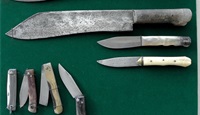
Applicant:
Lapithos Municipality
Communities Concerned - Bearers of the element:
Lapithos Municipality, Lapithos Cultural Foundation, “Lapithos” Refugee Association, Ephorate of Lapithos schools, old and young traditional crafts persons who bear the knowledge of making the knives.
Domain of Intangible Cultural Heritage:
Traditional craftsmanship
Date of inscription:
2017
Geographical distribution:
Lapithos still remains the only community in Cyprus where this element is still practiced, whereas in the old times there used to be a limited number of knife-makers or cutlers amongst metalworkers-blacksmiths around Cyprus. However, traditionally Lapithos has always been the knife-making place par excellence, both in terms of quality as well as quantity on a professional and commercial scale.
Lapithos is geographically situated on the northern coast of Cyprus, thirteen kilometres west of Kyrenia. The residential area expands from the coast to the foot of the Pentadaktylos mountain range. Nowadays (since 1974) the temporary offices of the Lapithos Municipality and of the organised groups are found in Nicosia, on 36 Prodromou Street, 20163 Strovolos.
The element survives mainly in the places where Lapithos refugees live and the Lapithos inhabitants are now scattered all over Cyprus and abroad, in all major cities of Cyprus (Nicosia, Limassol, Larnaca and Pafos) as well as in several rural areas, such as Episcopi and Ayia Fyla in the Limassol area, Mantria in the Pafos district, Mammari in the Nicosia district and elsewhere.
Brief description:
The Lapithos knife, as well as the pocket knife (“tchiakkoudi”) are hand crafted creations made up of two main parts: the metal part, in other words the blade (known as “kourtella” from the Italian “coltello”) which is usually made of steel, and the handle which is made of wood, ox bone or ram’s horn, as appropriate.
The same process is followed and the same materials are used for making both knives and “tchiakkoudi” pocket-knives. There is however one main crucial difference: the knife is a one-piece item, whereas the “tchiakkoudi” is a folding knife, ideal and safe for carrying in a pocket and in a bag.
The handle materials are found locally, whereas the steel is imported as raw steel for industrial use. It can even be retrieved from steel parts of old machines and vehicles. The “tchiakkoudi” handle is made exclusively from ram’s horn thanks to the greater flexibility this material has whilst processing. The inner part is carved in a wavy shape to follow the fingers of the hand and provide a good grip, whereas the back is wider and “V” shaped to prevent it from slipping in the user’s hand.
The Lapithos “tchiakkoudi” pocket knife bears three different names in the local dialect: the larger sized one is known as “tchiakka”, the medium sized one which was also the most common type is called “tchiakki” and the smallest one is known as “tchiakkoudi” or “tchiakkoui”. Depending on their use (professional or household), the Lapithos knives had several names: butcher’s knives for slaughtering and skinning animals, cleavers and choppers (“pala”) for meat cutting and chopping etc. whereas in the households we find cleavers and kitchen knives as well as smaller table knives. On the wider side of the blade, especially on butcher’s knives and large “tchiakka” knives there was a dent along the line of the blade, apparently to introduce air into the animal’s body during slaughtering and to be more effective.
Nowadays, people have an interest in collecting traditional knives from traditional craftsmen for various reasons. First of all to keep them as mementos for clearly historical, traditional and sentimental reasons, since until recent decades this was the only available utensil for daily household or professional use. It is also used for practical purposes, as it is safe and easy to carry, but also effective (sharp and pointed). When the knife becomes blunt (the edge is dull and no longer sharp) it can be easily re-conditioned by sharpening the blade.